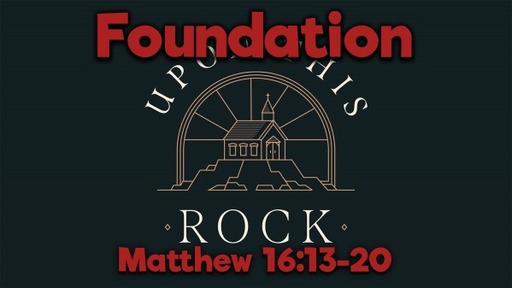Foundation

Location
In this instance, this likely refers to the realm of the dead in general (the underworld)—similar to the Hebrew word she’ol. Jesus and His disciples are at Caesarea Philippi, located at the base of Mount Hermon. This region is affiliated in ancient Near Eastern, Jewish, and Greek literature with the gateway to the underworld, the gods, and other spiritual beings. The OT also affiliates the region, called Bashan in the OT, with an evil giant clan and idolatry (Deut 2:10–12; 3:1,10–11; Josh 12:1–5). Jesus seems to be saying that through His power, the Church will overcome the powers of evil and death itself.
Since the original Greek text lacks the preposition “against” in the verse, the phrase may be literally rendered “the gates of Hades shall not withstand it.” Given this, the verse indicates that the gates of Hades, the realm of death and evil, will not be able to withstand the advance of the Church.
Identity
He questions their perception of the crowds’ views of his identity, not for his own information but to correct the misconceptions that have arisen.
Explanation
The equation with John the Baptist recalls Herod’s fears in 14:2 and suggests that others shared these sentiments. Elijah represents the messianic forerunner of Old Testament prophecy (see comments under 11:7–15). Many had obviously not made the link between Elijah and John the Baptist. It would be natural to think of Jesus also as a kind of Jeremiah, a preacher of judgment and repentance who was widely rejected by the leaders of his nation.
Jesus presses the disciples further for their response (v. 15). “You” here is emphatic. “I” makes it clear that the “Son of Man” in v. 13 is Jesus.
Here is the first time in Matthew that anyone in Jesus’ audiences has unambiguously acknowledged him as the “Christ” (Christos—Messiah—see under 1:1).
Peter also adds the adjective “living,” a characteristically Jewish way of referring to God to distinguish him from lifeless idols and also a reminder that only Yahweh has life in himself which he can impart to others. But the disciples’ insight has now definitely surpassed that of their Jewish contemporaries.
Understanding
Acknowledging Jesus as the Christ illustrates the appropriateness of Simon’s nickname, “Peter” (Petros = rock). This is not the first time Simon has been called Peter (cf. John 1:42), but it is certainly the most famous. Jesus’ declaration, “You are Peter,” parallels Peter’s confession, “You are the Christ,” as if to say, “Since you can tell me who I am, I will tell you who you are.”
The expression “this rock” almost certainly refers to Peter, following immediately after his name, just as the words following “the Christ” in v. 16 applied to Jesus. The play on words in the Greek between Peter’s name (Petros) and the word “rock” (petra) makes sense only if Peter is the rock and if Jesus is about to explain the significance of this identification.
Once Matt 13 is recognized as in no sense an absolute rejection of the Jews as a whole, it is virtually impossible to sustain the view that Jesus is here offering the church as an alternative to the kingdom. Instead, Christ’s “church” will comprise the community of people who submit to God’s kingly rule (recall that kingdom equals kingship—God’s rule or reign).
The popular view that the church is somehow to separate itself from society, based on the derivation of ekklēsia from ekkaleō (to call out) affords a classic example of what linguists call the etymological fallacy. Words often develop meanings over time that differ from their roots. The only sense in which the word church in New Testament times means those who are called out is that believers routinely gather together by leaving their separate places of residence or work.
Jesus promises the indestructibility of his church. That the “gates of Hades will not overcome it” proves cryptic because gates are naturally seen as defensive protection, while “overcome” suggests an army on the offense. Is Jesus saying that Hades (Heb. Sheol—the grave—probably, as with hell, in the sense of Satan’s domain) cannot conquer the church or that it cannot resist the church’s advances? Is Satan on the defense or offense here? The latter seems more likely. In other Jewish literature “gates of Hades” is frequently idiomatic for “powers of death” (based on Isa 38:10).
Similarly here Jesus encourages his followers that, irrespective of how Christianity may be attacked in a given place and time, the church universal will never be extinguished. Sects and cults which claim that true Christianity entirely disappeared from the world during certain periods of church history contradict Jesus’ teaching here.
Binding and releasing may refer to what Peter and the church leaders prohibit (bind) or permit (release). This seems to indicate that the Church and its leadership are given authority to carry out God’s will and to oppose the powers of evil (compare Matt 12:29–32).
As the next passage indicates, Jesus knows that His messianic role will involve suffering and death, and He apparently recognizes a divine timetable for these events to unfold.
